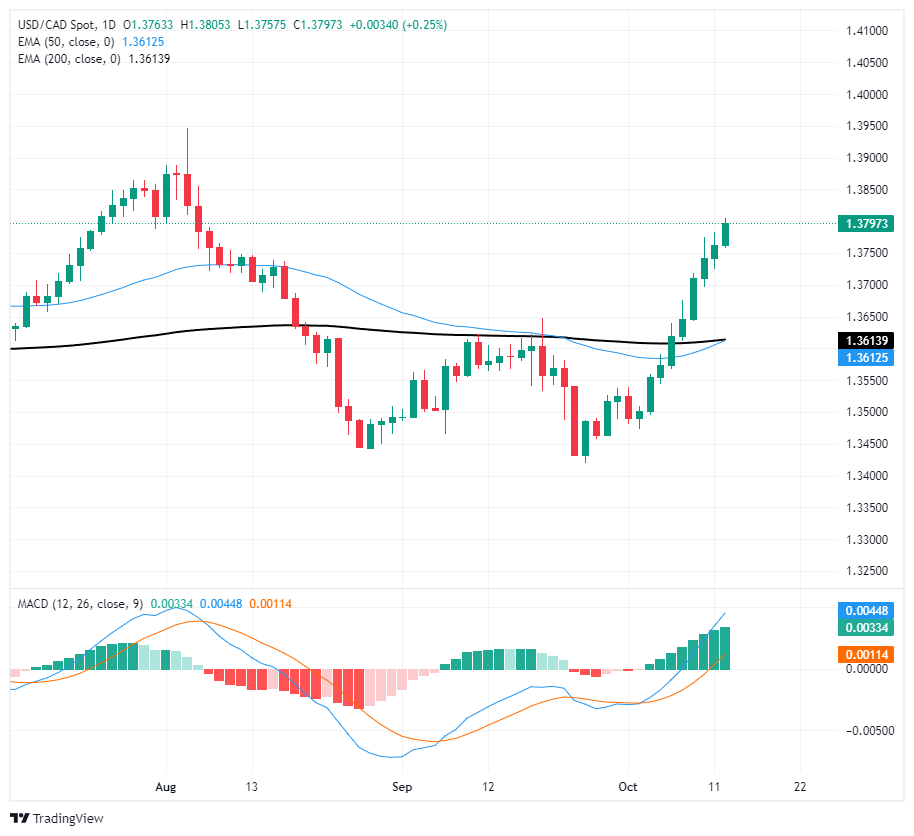- The Canadian Dollar lost another quarter of a percentage point against the Dollar.
- Canada began a new week of operations with an extended holiday.
- Canadian CPI inflation figures are due out on Tuesday, BoC rate decision looms on the horizon.
The Canadian Dollar (CAD) started the new trading week with another loss against the US Dollar, falling another quarter of a percentage point against the Dollar. The Loonie has fallen against the USD for the ninth consecutive trading day, losing almost 3% from September’s seven-month peak.
Canadian Consumer Price Index (CPI) inflation figures will be released on Tuesday, just in time for Canadian stock markets to return to action after an extended Thanksgiving weekend in Canada.
Market drivers
- The Canadian Dollar lost another quarter of a percentage point as Loonie traders continue to abandon the CAD and global currency markets push the Dollar even higher.
- Canadian markets are closed on Monday for the extended Thanksgiving weekend.
- The Canadian CPI for September will be released on Tuesday.
- The latest core CPI reading from the Bank of Canada (BoC) was 1.5% year-on-year.
- The Canadian Wholesale Price Index for September is expected to decline to 1.8% year-on-year from 2.0% previously.
- The Canadian CPI inflation figures are unlikely to generate much positive sentiment for the CAD as the BoC is widely expected to cut interest rates by another 50 basis points on October 23.
Canadian Dollar Price Forecast
USD/CAD is showing a clear bullish trend on the daily candles, with the pair breaking above its 50-day EMA near 1.3600, and is now trading at 1.3800. The pair has risen steadily after a brief consolidation phase in mid-September, indicating strong bullish momentum. The 50-day EMA is about to cross above the 200-day EMA, forming a bullish crossover known as a “golden cross,” which typically signals a long-term bullish trend.
In terms of momentum indicators, the moving average convergence/divergence (MACD) indicator is also showing a strong bullish crossover. The MACD fast line (blue) has moved above the signal line (orange), and the histogram is rising, confirming the strengthening of bullish momentum and implying that the current rally could extend in the near term.
Looking ahead, the next key resistance level is around 1.38500, just above current prices, where sellers could intervene. To the downside, support lies near the 50 and 200 day EMAs which are consolidating near 1.3600, which should act as a strong buffer against any corrective move. As long as the pair remains above these levels, the outlook remains bullish with the potential for continued gains.
USD/CAD Daily Chart
The Canadian Dollar FAQs
The key factors that determine the price of the Canadian Dollar (CAD) are the level of interest rates set by the Bank of Canada (BoC), the price of oil, Canada’s main export product, the health of its economy, inflation and the trade balance, which is the difference between the value of Canadian exports and its imports. Other factors are market confidence, that is, whether investors bet on riskier assets (risk-on) or look for safe assets (risk-off), with the risk-on being positive for the CAD. As its largest trading partner, the health of the US economy is also a key factor influencing the Canadian dollar.
The Bank of Canada (BoC) exerts significant influence over the Canadian Dollar by setting the level of interest rates that banks can lend to each other. This influences the level of interest rates for everyone. The BoC’s main objective is to keep inflation between 1% and 3% by adjusting interest rates up or down. Relatively high interest rates are usually positive for the CAD. The Bank of Canada can also use quantitative easing and tightening to influence credit conditions, with the former being negative for the CAD and the latter being positive for the CAD.
The price of oil is a key factor influencing the value of the Canadian Dollar. Oil is Canada’s largest export, so the price of oil tends to have an immediate impact on the value of the CAD. Generally, if the price of oil rises, the CAD also rises, as aggregate demand for the currency increases. The opposite occurs if the price of oil falls. Higher oil prices also tend to lead to a higher probability of a positive trade balance, which also supports the CAD.
Although inflation has traditionally always been considered a negative factor for a currency, as it reduces the value of money, the opposite has actually happened in modern times, with the relaxation of cross-border capital controls. Higher inflation often leads central banks to raise interest rates, attracting more capital inflows from global investors looking for a lucrative place to store their money. This increases the demand for the local currency, which in the case of Canada is the Canadian Dollar.
The published macroeconomic data measures the health of the economy and may have an impact on the Canadian dollar. Indicators such as GDP, manufacturing and services PMIs, employment and consumer confidence surveys can influence the direction of the CAD. A strong economy is good for the Canadian dollar. Not only does it attract more foreign investment, but it may encourage the Bank of Canada to raise interest rates, resulting in a stronger currency. However, if economic data is weak, the CAD is likely to fall.
Source: Fx Street
I am Joshua Winder, a senior-level journalist and editor at World Stock Market. I specialize in covering news related to the stock market and economic trends. With more than 8 years of experience in this field, I have become an expert in financial reporting.







